Origin
CCCats are a sentient, magical parasite species. Starting out as a Wormling, they travel in search of a suitable host body. Once a suitable host body has been found, the wormling attaches itself -changing its shape to better match the CCCat blueprint- and begins a life of its own.
There exist entities within the planet of Eeridi that consume magic without ever releasing it back into the world, leading the magic to become sunken or "tangled". As a newly made creator, Skire (Entity) understood that its magic was a limited resource, so it being returned and cycled back into the world was paramount in order to keep Skire (Landmass) from losing its natural abudance of magic and eventually perishing. Skire set out to create a rule of reality that allowed that sunken magic to be recycled and converted into something new. Before Skire's new law of reality, there was nothing that could extract magic from places where it had become sunken. Thus, Wormkin (CCCats and Crookeds) found themselves created to help recycle that magic back into Skire.
CCCats possess a unique ability to consume magic and untangle it from its sunken state. As magic filters through a CCCat's body, it is changed back into its pure, separated form rather than its tangled or 'sunken' forms. This pure untangled magic is then released back to the planet to be used by others. CCCats are heavily impacted by the magic that they untangle, which is one of the main causes for Magical Defects appearing on their hosts.
CCCats will live forever if undisturbed by other creatures, so there is no average lifespan.
Anatomy
A CCCat begins life as a Wormling , and though they can grow and change reproductive organs at will, CCCats do not and cannot physically reproduce.
When a CCCat takes their host, the body is changed both internally and externally. The first of many changes is to absorb any unneeded organs, which then provides the energy needed to transform the bones, muscles and skin into something more suitable.
The basis of a CCCat blueprint is a form that is fit to protect and transport the 'eye' and 'tongue':
- Four limbs, each with an opposable set of fingers able to hold on tightly to its eye while it is external.
- A neck equipped with a pouch for holding the curled tongue, and a 'stomach' pouch to hold the eye internally.
- A spherical skull and set of interlocking teeth strong enough to protect the eye held in the mouth from almost anything.
- Crown spikes which allow the wormling to keep control of its host body, and contact with the Hivemind.
- The tongue (original wormling) attached to the spine of the host.
- The eye orb (the CCCat's external brain) completely separate from the host and can move freely between the externals and internals.
The outer appearance and patterning of a CCCat is usually a combination of its host's appearance and the sights, sounds, and other sensations the wormling felt and experienced throughout its journey to find its host.
Any other parts kept in the body (like lungs, reproductive organs, etc.) are not essential, and are kept mostly by the individual's preference to have them. The host body of a CCCat is not "revived" when it is taken; parts are kept and repurposed, similar to how an organ donor's heart or other vital organs might be transplanted after death to a living person. None of the previous entity's sentience is retained, and it is not being "shared". The circulatory systems are run passively without need for lungs or a heart.
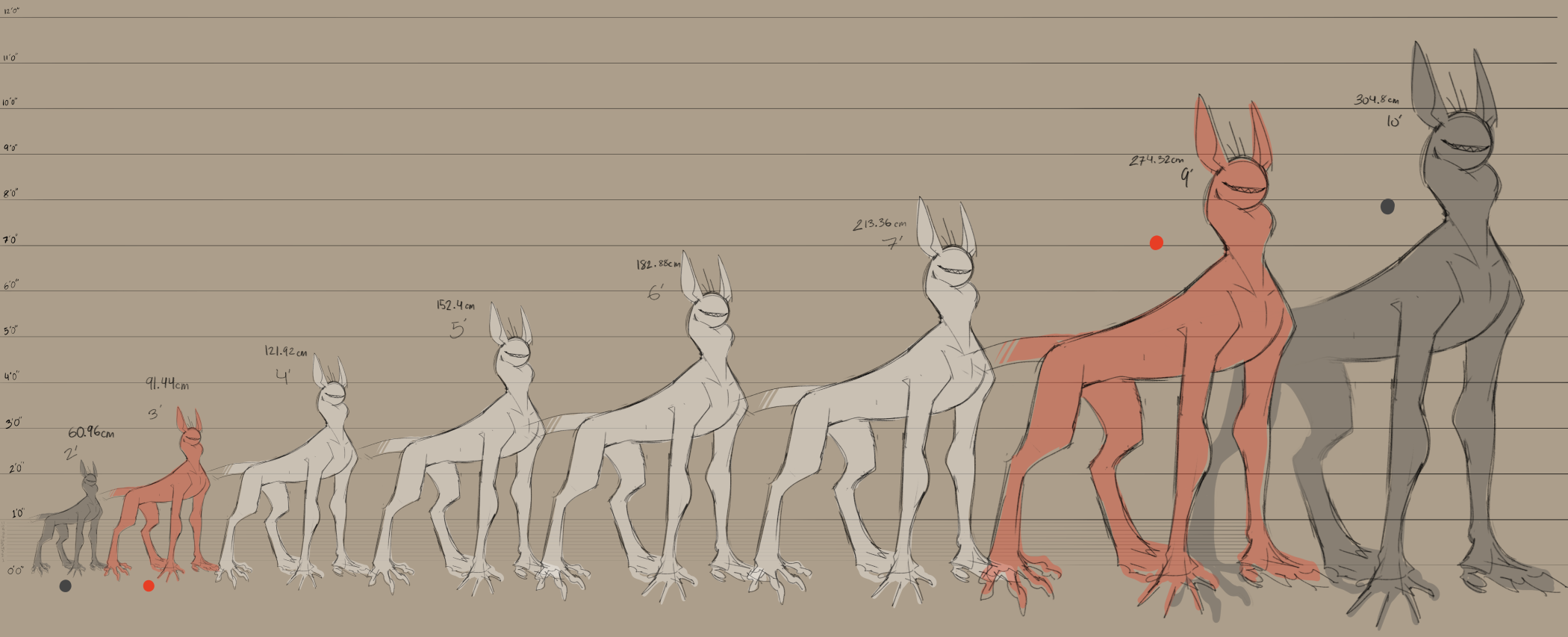
CCCats can have a small range of heights (white) and can have one main size they take naturally. Beyond their main size they can size up or down one from that main size. Chibi and Monster sizes (orange) are unique to only myth-traited CCCats, and Extra Tiny or Extra Large sizes (Gray) are unique to Touched-traited CCCats.
When a CCCat changes stance from quadrupedal to bipedal (humanoid), their body will magically shift to retain its height. For example, if a CCCat was 7' tall when standing on four legs, they would still be 7' tall when they shift into a haumanoid stance.
Anatomy Continued-
Even when standing on all-fours, CCCats have a relatively human-like body type. Their back legs tend to be digitigrade, while their front limbs are plantigrade with palms on the ground. To retain proper movement and posture, the front limbs of a CCCat are elongated, and usually the chest is elevated taller than the hips. The torso is humanoid, with a humanoid ribcage and musculature to match.
When a CCCat shifts to a biped posture, not much about their anatomy changes. The main differences lie in the orientation of their hips and the length of their front limbs, which tend to become shorter to help balance more easily on two legs.
CCCats can completely dislocate their bones, and stretch/tear their muscle structure to create bends not perceived as normally possible. Without proper experience doing so, the act can be rather painful. CCCats also have the ability to stick to walls ceilings; easily traversing up smooth surfaces, slopes, and cliffs.
A CCCat has many ways of expressing emotions. They can cry, though depending on the mode (Cyclops or Mouth) the fluid may appear more like saliva or drool. They can blush, which can appear on areas like the face, ears, chest and shoulders. Other effects of emotions can be displayed by the ears, crowns, and fur.
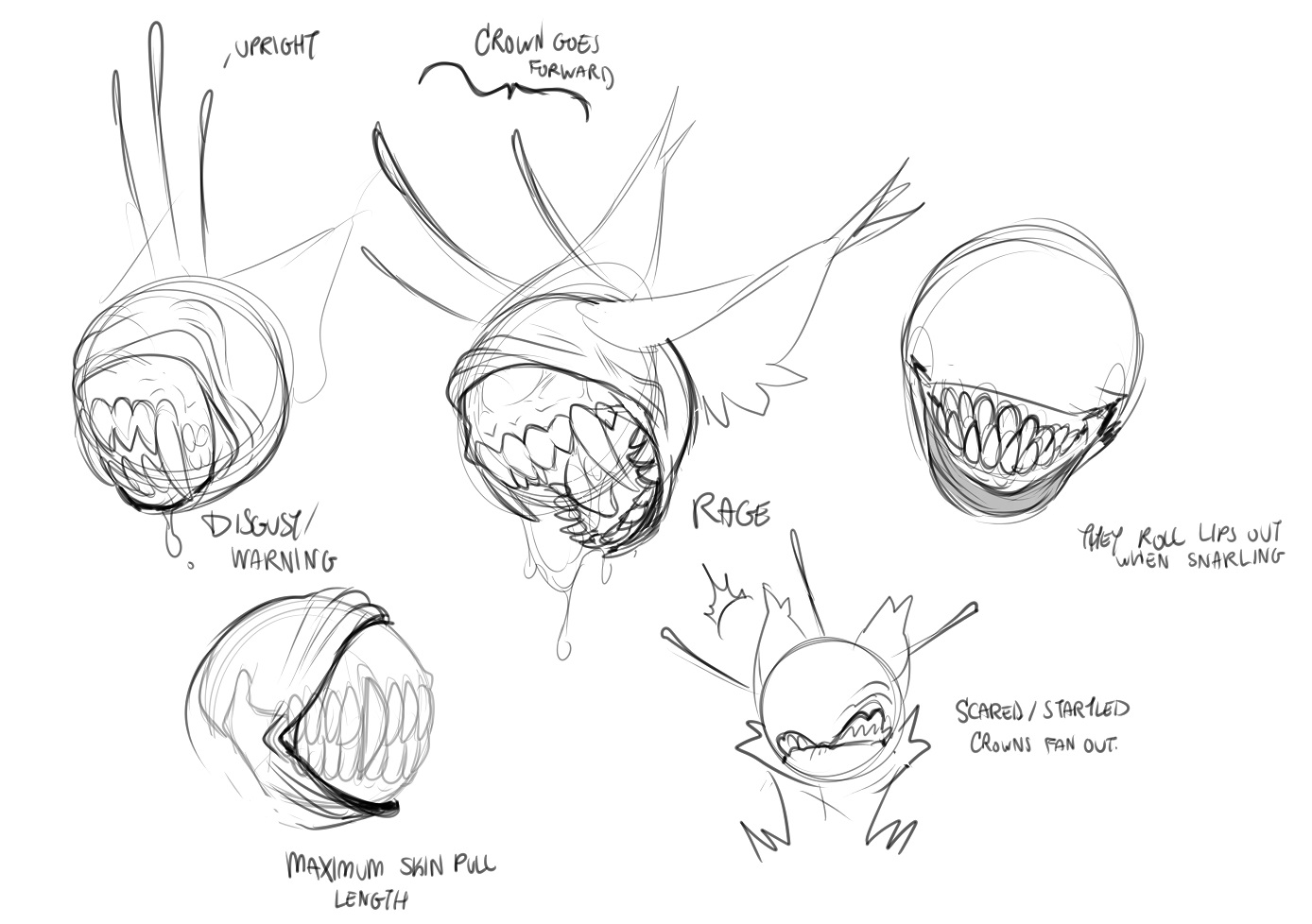
CCCats can snarl and pull back their lips around their skull to an extensive degree. The inside of their lips are black in color, but can fade to different colors for the inner mouth and gums. They can also purr, but it comes from deeper in the throat rather than from a non-existent nose, causing it to sound more guttural and gurgly.
Body temperature varies from CCCat to CCCat, but can be described as being cold-blooded with a mid body temperature that fluctuates based on the environment. A CCCat can generate its own heat with movement, however they do not run "hot" or "cold" unless magically affected. A CCCat trained in Ice magic may have a low or freezing body temperature, while one trained in Fire magic might be hot to the touch. A CCCat may prefer a certain environmental temperature due to the "memory" of the host body. For example, a CCCat with a mammalian host might prefer temperate climates, while one with an avian or reptilian host might find they prefer warmer places.
CCCat fur has a range of textures, although it is generally soft to the touch similar to a domestic cat. However a CCCat cannot retract its claws like a feline, as its hands function similar to a primate's hands with additional sharp talons.
CCCats can sweat if they desire, and if they do most of the glands are located on/between their paw pads and palms.
Internals
CCCats may choose to retain certain host organs even if they are not necessary to their blueprint. Things like lungs, hearts, and stomachs are kept most often. They can choose to simulate breathing, though it does not come to them naturally. The retention of the host's lungs may aid in this, but it will still take practice for a CCCat to achieve a natural cadence of breath. They may also keep a pseudo-heart which will beat messily out of any sort of rhythm. A kept stomach will not process food normally; instead absorbing and breaking it down into its magical basic form. A CCCat may still enjoy eating as a social or personal activity.
Sleeping is also not necessary, though it may be done for similar social or personal indulgence. Meditation is a popular alternative to sleep, as it helps the CCCat process the day's happenings and regenerate magic.
Senses
CCCats have scent glands in the roof of their mouths towards the upper back of their front teeth. They cannot truly sneeze since they do not have nostrils, but a similar action can happen due to scent or particles irritating these glands. An irritant in the throat might cause a coughing-sneeze or snort, or a strong buildup of magic could also cause a CCCat to 'sneeze' to try and expell it.
CCCats have standard hearing akin to an animal, though the quality of their hearing can be greatly impacted by the shape their ears take. A CCCat with large erect ears may have very excellent hearing, while one with small drooping ears might have more standard hearing.
CCCats can taste and the method by which they do so is akin to humans; using the buds and pores of their tongue. Most taste buds are located at the back of the wormling tongue. Taste can be intensified by combination with smell.
See Eyes section for sight
Disabilities
CCCats can gain or be formed with disabilities just like humans can, though it is much more uncommon for disabilities to form that change their blueprint too drastically. Most of the time these physical disabilities are gained over time or by injury.
It is not impossible for a CCCat to become deaf or hearing impaired from an injury they can’t heal, or even possibly retain the impairment from its host. Even if deaf, the CCCat will still be able to hear other CCCats speaking to them through the hivemind, and could hear other Skireans speaking to them telepathically.
Sight imparement is much more unusual for CCCats, but not impossible. Many factors in their development might contribute to differences in sight. Two such defined conditions are Color Blindness and Omen Sight. These afflictions are easy to be identified by others, as the CCCat's coat colors will be visibly affected. CCCats that form with Color Blindness may see the world differently, and like human color blindness it can be slightly different from individual to individual. The body of a Color Blind CCCat might be pastel, monochrome, or muted in color. Complete color blindness where no color is able to be seen is called Omen Sight. When a CCCat has Omen Sight, it means they have the unique ability to see the passive weave of Luck magic, which is usually invisible to others. This condition is usually apparent by the lack of any color on the CCCat's body, or a majority of their body being colored in greyscale, black, and/or white.
It is not possible for a CCCat to be fully blind unless the CCCat has been cursed by a Guardian.
It is possible for CCCats to lose limbs and not have enough magic to regenerate them. Skireans can live without limbs, or if desired they can have prosthetics made for them.
Eye
The Eye orb of a CCCat is essentially the brain which contains the thoughts, sentience, and essence. Though this 'brain' is a purely magical object, a CCCat will develop its own individuality, personality, and habits based on its experiences and memories. The eye sends signals to the crowns which then control the host body much like how a brain sends signals through the nervous system in the body.
A CCCat’s eye cannot be damaged beyond that of a God or Guardian's force or power, and so pain is not something that an eye can feel. In the event that an eye is damaged by a deity, the effect feels like a visual disturbance, or a gut feeling of something not being right rather than physical pain. The CCCat may feel "off" or have trouble controlling aspects of itself.
It is believed that one of the most severe punishments from the CCCat Guardian, Everything, is to crack or curse one's eye.
When a CCCat's eye is cracked, the essence -its lifeblood- slowly leaks out. Magic is circulated to create essence, and if a decent amount is lost in the process, the CCCat will need to consume much more magic to be able to operate at a normal level. The strain from having to process so much more magic and constantly being leached of its life force eventually will lead to death. For a creature who's lifespan is almost unending, the chance of death at all is its own burden to bare.
When a CCCat's eye is cursed, the result is not as straight forward as a cracked eye. To have a curse on one's eye harms not only the individual, but anyone who desires to get close to them as well. A cursed eye can truly ostracize a CCCat from its kin; making it difficult to socialize or build bonds. The effect of a cursed eye can largely vary from inflicting pain, to giving off an intimidating, sickly aura that deters others, to hindering one's ability to comfortably carry their own eye. The ladder can make it especially difficult to survive when keeping hold of the eye is paramount to a CCCat's survival. To be cursed is not a punishment given lightly. Those with cursed eyes have done severe wrongs or angered the guardians greatly.
A CCCat’s eye cannot feel any sensations, but they can imagine them. Once connected to a host they understand and process sensations like a brain does.
A CCCat can shift their eye size, however they are limited to how much they can change it once they find their host. The shift in size is usually to fit the body in which it resides. When the eye is free, it may be smaller than if it were being held in Cyclops mode where it must fit to the mouth, and again may be much smaller if the CCCat is taking a humanoid form in order to fit into an eye socket.
An eye can comparatively range from the size of a golf ball to a basketball depending on the size of the CCCat.
The inner eye of a CCCat contains what is called Essence. This liquid is considered a CCCat’s true life blood and is pure magic in a raw, untouched form. The eye will collect and build it up from magic it consumes and untangles, storing it tightly and creating a unique mixture only it has. The essence within the eye radiates a unique aura that the crown of that CCCat host responds to exclusively.
Magic Sight
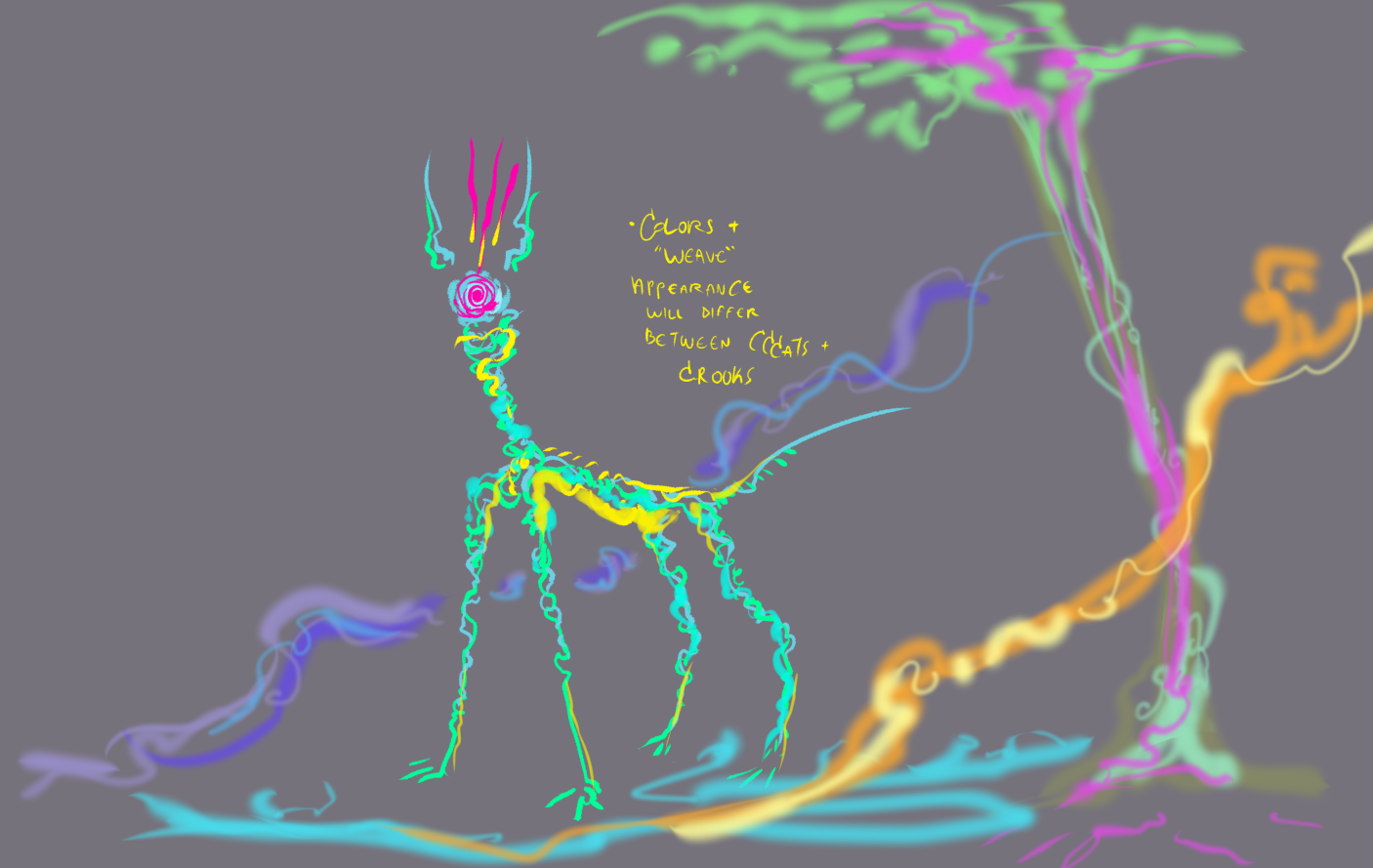
CCCats do not see quite like how humans see. Instead, they experience sight by reading the magic weave that flows through everything in the world.
When a CCCat’s eye is within its pouch, they can still see through this magic sight. They can feel other's magic and can see basic shapes, as well as the identifying magical weave that is unique to every individual around them. The magic color, weave pattern, and individual strings have different qualities to them depending on what they are. Environmental structures like mountains and flora have entirely different weaves compared to fauna. Where a rock might have a rigid pattern of magic, a bird might have a more loosely coiled set of strings.
For CCCats and Crooks, their magic weaves appear very tangled and condensed; made up of very brightly colored chords intermixed with smaller different colored strings and pieces of strings from the magic that individual may be cycling. The distance of objects from a CCCat is differentiated by its detail and starkness. Objects or people that are far away may appear fuzzy or blurry, while close objects or people will be crisp and well-defined in their structure.
A CCCat's natural eyesight is exceptionally good; seeing in stereoscopic vision despite having a single eye orb. They can suffer from sight impairments, but complete blindness is impossible unless caused by Guardian intervention.
Tongue

While Wormlings themselves do not have a sense of taste, once they inhabit a host they do acquire one, thus they become what is known as the 'Tongue'. The way that a CCCat tastes things differs from humans since this sense does not come naturally to them and they must essentially piece these aspects together for themselves once their host is made. Variance in taste or even not being able to taste certain types of flavors is common. Something that tastes sour to one CCCat may taste spicy to another, or something that tastes delicious to one CCCat may have no flavor to another. What they are told something should taste like can also impact how they actually experience the flavor.
Besides tasting things, the tongue is an essential organ able to hold and secure a CCCat's eye. They use it to feel and explore things like an extra limb, and may even favor using it to get an understanding of things over their actual hands due to its sensitivity. It is not uncommon to see a CCCat lick something they wish to investigate. Texture usually plays a bigger factor to them than taste.
A CCCat would not die if its tongue was cut off. The tongue is more than what is seen outside of the mouth, and spans almost the entire body fusing along the spine. Where it extends into the torso it expands and fills where vital organs of the host used to be. The tongue that is visible out of the mouth is rather lengthy, and when retracted will curl around itself inside a special pouch in the neck.
Teeth
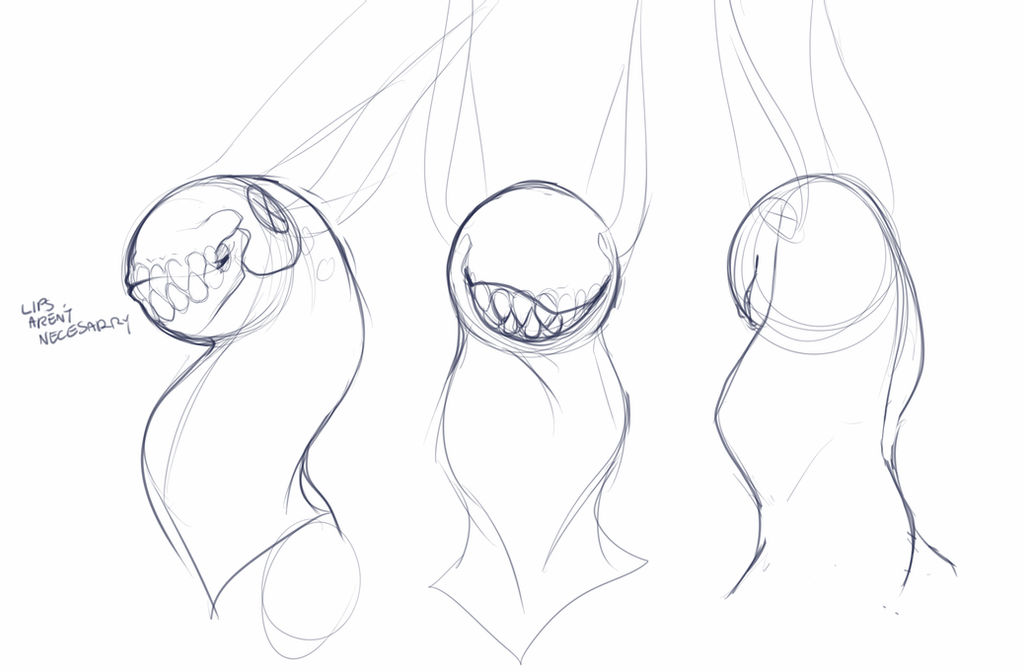
A CCCat's natural teeth are diamond shaped, interlocking, and extremely durable. Whatever material they are made of does not decay or rot, and it is near impossible to knock one out or break one.
When a CCCat's mouth is closed, its teeth form a tight seal that is void of any gaps or holes. All of them are uniform without difference, and do not appear to have anything akin to molars or grinding teeth. A CCCat may sometimes form with several longer teeth akin to fangs or saber tusks that can be in any position in the mouth. These teeth will overlap the ones under them and still form a tight seal when the teeth are clenched.
Crowns
All CCCats have a set of thin, quill-like protrusions that usually sprout from the back of their skull. These semi-flexible spikes are referred to as 'crowns'. The crowns of a CCCat can come in many lengths, shapes, and alignments. Though it is usual for them to be behind the ears at the back of the head, crown spikes can also form on the forehead, face, or very unconventionally on lower parts of the body.
A CCCat's crown is its connection with not only its host but the Hivemind as a whole. When a CCCat has less crown spikes, their connection to the Hivemind and other CCCats is weaker and usually cannot reach very far. More crown spikes means that the Hive 'voice' can be heard louder and farther, and so a CCCat with few crowns may interpret the voice coming through quietly, or with fuzziness or static. This feeling of static can compound if the CCCat is trying to communicate with more than one individual at a time.
These rather durable crowns cannot retract, but will regrow in the event that they are snapped or plucked out. The regrowth process of a damaged crown is not fast, and can take an extremely long time compared to the generally quick regeneration of other parts of a CCCat's anatomy. While damaged, the CCCat's connection to the hive and others is also hindered. It is considered a form of torture to constantly have them broken or plucked. Rarely, a crown may not regrow at all, and the remains of it may dust away leaving the CCCat permanently with less crowns.
If a CCCat were to somehow form without a crown, or the crowns were entirely removed, the CCCat would be immobile and could potentially die due to not being able to contain their eye safely or stop anyone from taking it.
Shapeshifting
CCCats possess the ability to shapeshift into different forms, most notably a humanoid form. Though the time and progression of a shift can differ between individuals, it is generally quick. Their size in each of their forms correlates to their respective size as a CCCat, but their humanoid form tends to stay within usual human heights and sizes.
When a CCCat shifts forms, they keep their eye color and majority of their design the same. Their teeth also remain the same; sharp and conical, matching any traits they may have in CCCat form. In humanoid or faun form, they can only have their one eye orb. The other eye socket, if they choose to form it, will remain empty. Alternatively, a CCCat in humanoid or faun form may not form eye sockets at all; preferring to keep their eye out of sight.
Any and all scars or wounds carry over to the other forms. Other traits a CCCat might have can show up in humanoid form, but are not required.
If a CCCat has never seen or interacted with humans before, the human form can be a little ‘off’ from what a normal human would look like. Though due to the hivemind, a good idea of what humans appear as is given even if the CCCat has never met them. A CCCat can take a Faun, Centaur, or Sphinx form in addition to a humanoid form.
Faun
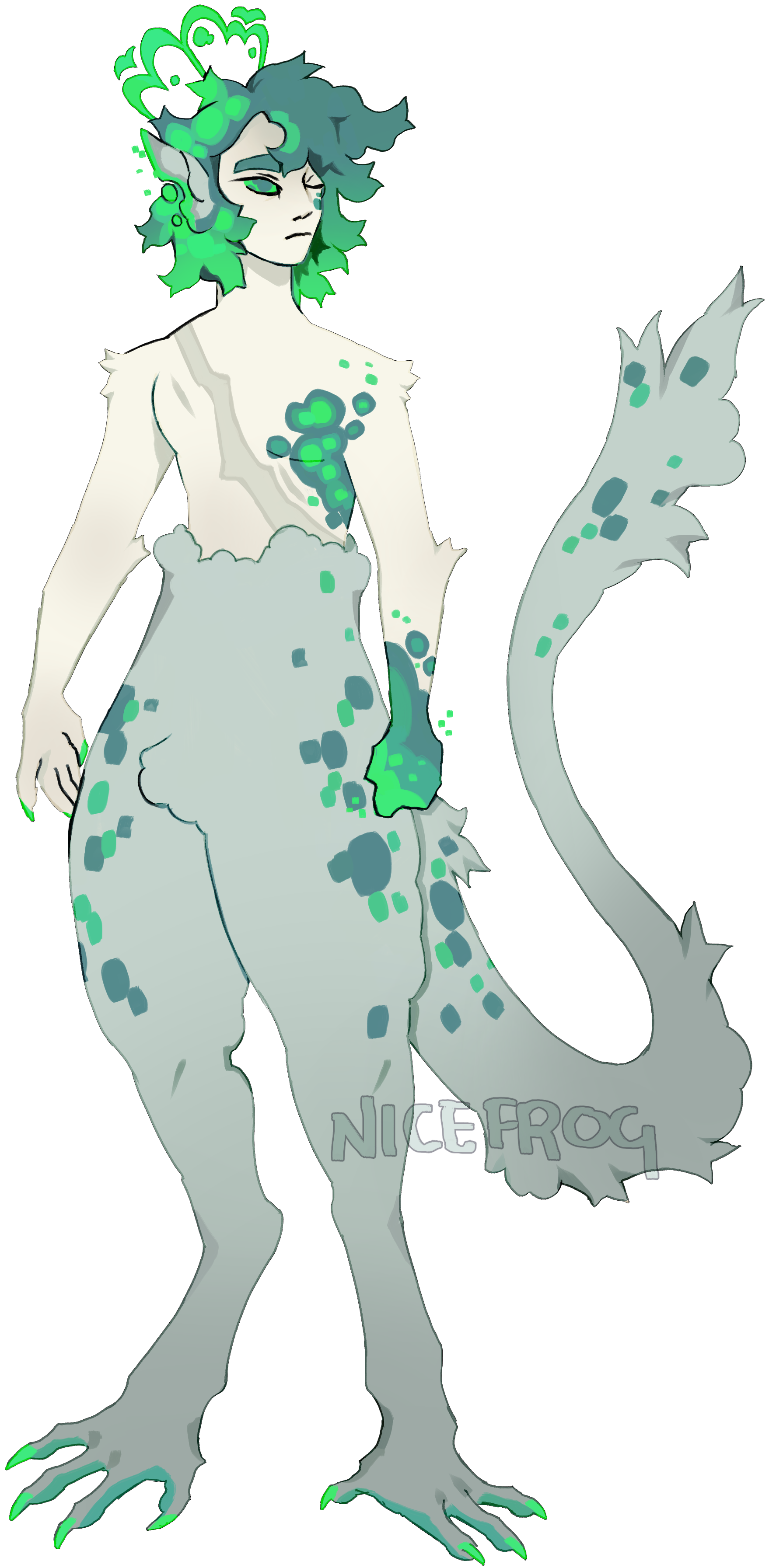
◆Upper half humanoid (follows humanoid rules).
◆Lower half matches CCCat lower body.
◆Missing Eye socket.
◆Tail present.
◆Humanoid half can have any skin tone or match the CCCat's markings. Markings can appear instead colored like the skin tone. Humanoid half may have human ears, and/or no nose.
◆May have hands with 4 to 5 fingers and claws or fingernails.
Centaur
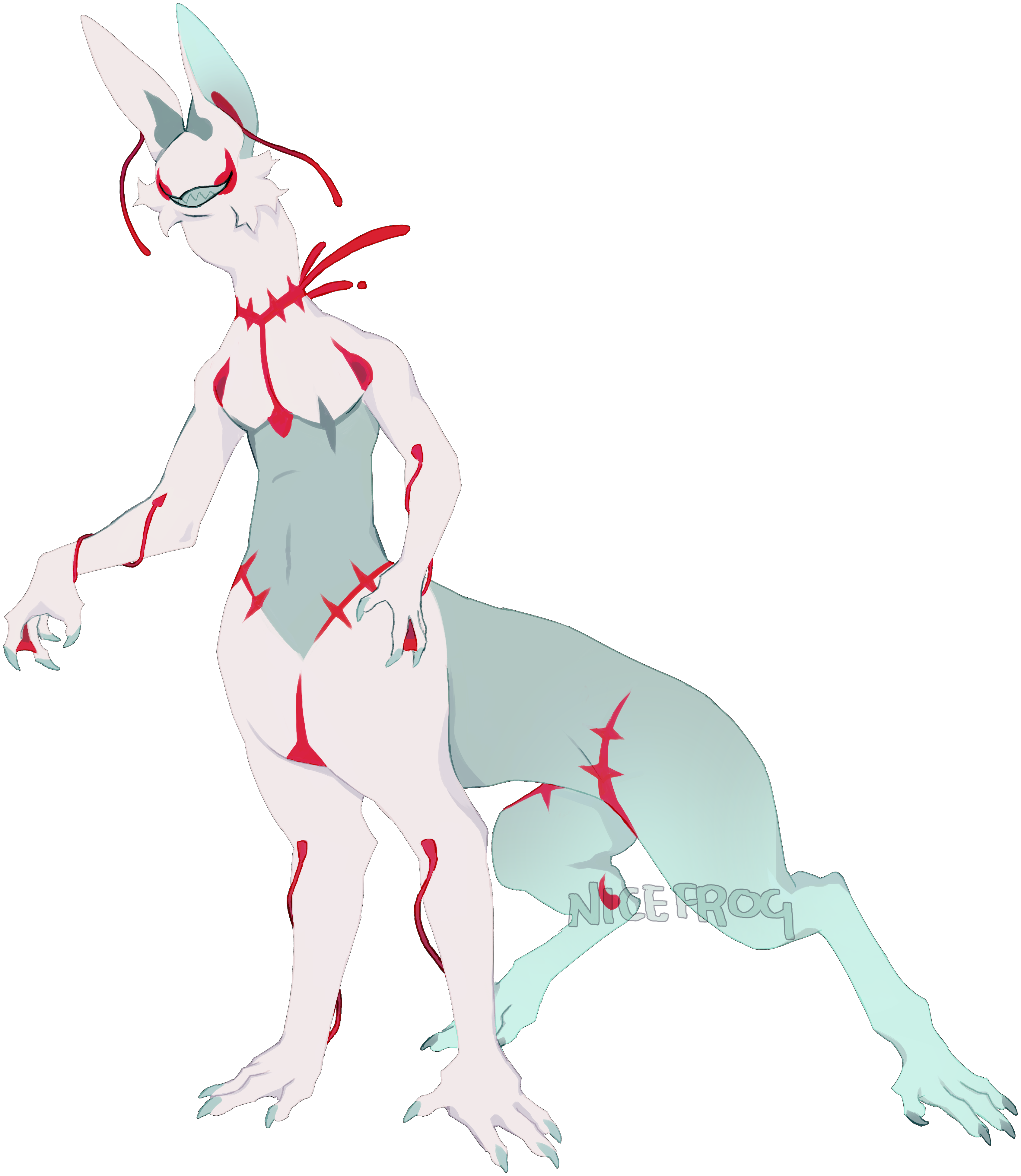
◆ CCCat torso emerges from the base CCCat body.
◆ CCCat lower body.
◆ Upper half humanoid (follows humanoid rules).
◆ Markings remain similar in placement to the standard form.
◆ Should not add any new markings or colors.
Sphinx
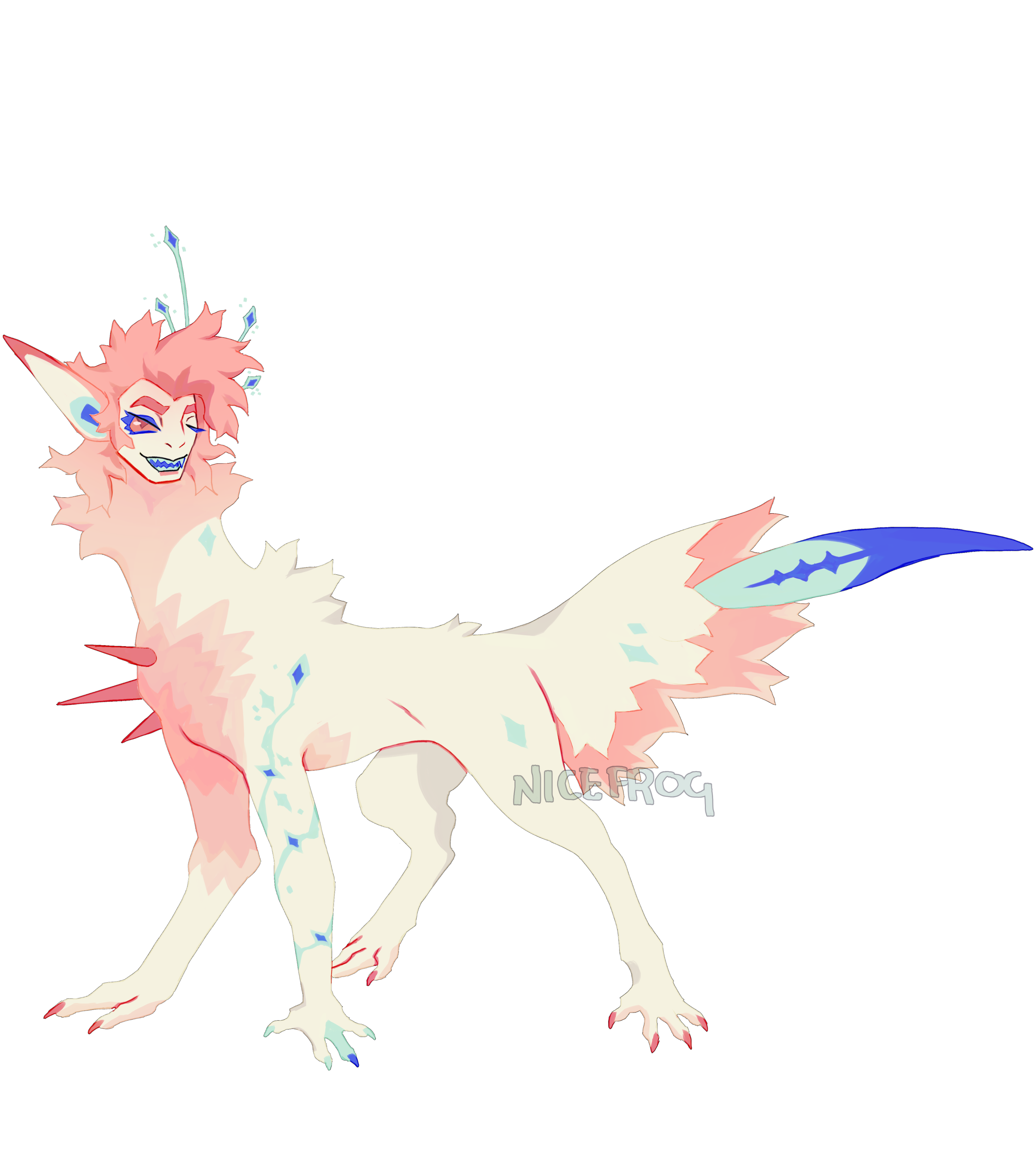
◆ Humanoid face (follows humanoid rules).
◆ CCCat body.
◆ Missing eye socket
◆Tail present.
◆Humanoid face can have any skin tone or match the CCCat's markings. Markings can appear instead colored like the skin tone. Humanoid half may have human ears, and/or no nose.
humanoid
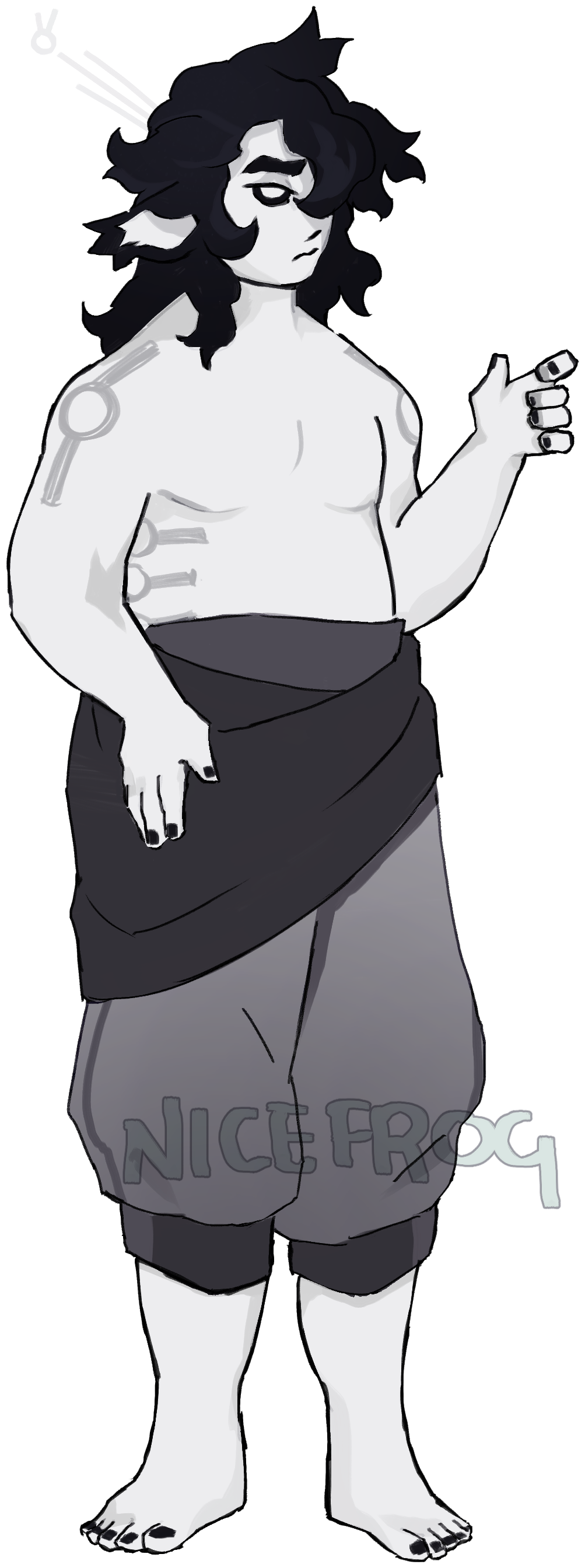
◆Singular eye in head that matches CCCat's eye.
◆ Sharp teeth matching the CCCat's teeth.
◆ Crownspikes.
◆ Missing eye socket.
◆ Tail present
◆ Humanoid form can have any skin tone or match the CCCat's markings. Markings can appear instead colored like the skin tone. Humanoid half may have human ears, and/or no nose.
◆ May have hands with 4 to 5 fingers and claws or fingernails.
(Open images in a new tab to see full detail)
Shapeshifters outside of the CCCat species can not take a CCCat form. A CCCat can sense when there is a false CCCat and become immediately wary. Being a parasitic species who are generally very tight-knit due to the hivemind, the mimicry of a CCCat from other creatures/species is seen as hostile no matter what; invoking an intense fear of “uncanny valley”, and sometimes an uncontrollable hostility even if they do not mean to.
Along with their ability to shapeshift into other forms, a CCCat can change its gender at will. CCCats start and by default are genderless, but can alter their body in human-like anatomical ways for however they wish to present. This can be anything from anatomical structure (such as larger hips or broader shoulders) to genitalia if they so choose. They are able to change this at any time to match their desired presentation and they can mix and match in order to best suit their own desired presentation.
Unique Traits
When a CCCat forms their body, they will always have a similar shape. However, they may form different traits from individual to individual; some being more rare than others. These uncommon, rare, and mythical traits are referred to as such because they are less often seen. The further an attribute strays from the base CCCat blueprint, the more "rare" it is.
Though CCCats and Crooks both form from Wormlings, a CCCat is less likely to adapt traits from its host as they follow a stricter blueprint. A trait like paws -while more common for Crookeds- is much rarer because it drastically changes the CCCat's ability to hold on to its eye.
Some traits are only given through special means, such as through the Guardians Everything and Nothing. These special traits are considered to be obtained when 'Touched' by the guardians; either when the CCCat is first formed, or when an existing CCCat has done or achieved something the guardians consider noteworthy.
One incredibly unique trait of note is a Two-Formed CCCat.
A Two-Formed CCCat is normally created when a CCCat remembers important things they may have forgotten as a Wormling. These things may have been important to the CCCat when creating it's host body, and so they are granted a boost of magic that allows them to create another potential body. This new form can look alike to its first, or completely different in every way, as it is considered a form of different important memories and experiences. Similarly, a new form can be an expression of finding out more about one's self, and so they're granted the chance to express that new self. Secondary forms can potentially cause behavioral changes that are prominent only in the secondary form. Despite this, the CCCat in its essence is always the same, just expressing theirself differently.
Rarely a CCCat can tap into these forgotten memories on its own, as it needs a boost of outside magic (usually from a guardian) to take it.
Survival
When they first find their forever host bodies, CCCats do have to learn how to walk. Basic survival skills come pretty quickly to Wormlings thanks to the Hivemind's teachings, but there is still an amount of time required for a new CCCat to proverbially get their legs under them.
A CCCat can survive virtually anywhere, even in space. However, this survival depends on the possession of their eye, and how much magic exists. If somehow a CCCat were cast out into a void of space where no magic coursed, they would likely perish.
CCCat’s cannot swap eyes, as they will suffer pain even from just touching another CCCat's eye. Much like cannibalism, due to the eye being a huge part of their magic, if a CCCat consumes or "uses" an eye that belongs to another CCCat they will suffer magic mixing. This magic mixing poisons the CCCat, and will slowly cause them to decay irreversibly.
CCCats are rather terrible swimmers and despite being able to learn how, most CCCats will avoid swimming or entering large/deep bodies of water on instinct. CCCats will not swim with their eye out and instead swallow it to ensure its safety if crossing water. The eye orb is too dense to float, and if a CCCat loses it's hold on it, the eye will sink. Their host body, due to its lightness, will usually be buoyant and they will rise back to the surface if they try to dive too deep. CCCats with host traits that allow them to more freely swim and traverse water may have less of an aversion to it, but tend to still be very careful with their eye orbs.
CCCats do not usually scar, as they can heal wounds rather quickly. A CCCat can choose to keep certain scars, and major impact injuries will scar if a CCCat forgoes healing it in the moment. Due to their ability to pinpoint magic and heal wounds more quickly, small wounds like paper cuts, bruises, and even tattoos will simply disappear within a few hours or days as the CCCat regenerates itself back to its truest base form. Larger injuries like limb loss or gaping wounds require a CCCat to manually pinpoint their magic to focus on healing. This can take time and constant focus in order to regrow the lost parts. If they do not spend the time and effort to do so, if they are too weak, or they don't have enough magic, the part will remain lost. In this case, some CCCats may get non-electronic prosthetics for their missing limbs.
CCCats cannot be infected by regular nor magical parasites. Their bodies have a tendency to break down whatever enters past their skin into a pure magical state. Though their stomachs/pouches do a better job at this, their bodies will reject the intruder or break it down. Sickness is unusual for CCCats and wouldn’t show any external signs of illness. They have sensitivities to certain things (like unique magics) and have reactions much like a human would with allergies.
Things like cigarettes, alcohol, and drugs are able to be indulged in - though a CCCat wouldn’t receive any negative side effect nor addiction. Any organ that a CCCat has that may be damaged from one of these substances are healed. CCCats can get piercings, however if a piece is out too long the hole will heal over quickly.
If a CCCat is known to be murderous, CCCat society will react very similarly to human society. The offender is cast out, or even killed on sight. CCCats don’t have their own law system in place (though depending on the location they occupy there may be varying laws), but usually cannibals, murderers, serial killers, or other types of CCCats that kill their own kind get attacked by their own kind. They are seen as harming the hivemind, and similarly to a hive of bees CCCats will look to remove anything that harms their kin.
Mortality
Though a CCCat does not have the same essential needs as other species, they are not entirely invincible. Only a small handful of methods have been noted as irreversibly fatal to CCCats: Acid (That melts Skin/Metal), Severe Fire (That melts their bodies), Severing the Body (Only at Specific Points), Eye-Swapping, the God’s/Guardian's wrath, or the removal of the eye from the body either too far or for too long. Otherwise, they are highly resistant to most radiations and poisons, though it can slow them down if administered in large quantities.
CCCats can be temporarily "killed" or stalled by causing heavy damage to their host, but leaving them on the brink of death to just barely heal and then be wounded again is more akin to torture.
Lifestyle & Socializing
The lifestyle of a CCCat varies extremely from one to the next, and there is no ‘set’ lifestyle that a CCCat has to live. The decision of where and how they live is entirely up to them to choose. Where some CCCats prefer to live in the wild or away from civilization, some may want to live within the cities of humans or sometimes even in a human's home. CCCats can even live outside of Skire (Landmass), though there are not many that occupy those uncharted lands, as they are without much magical power.
CCCats are parasites that tend to adapt to their surroundings. A culture or society near to their host may be one they adapt to, or they may choose to travel to find one that suits them personally. CCCats have merged their way into other populations rather than creating their own. There are CCCat-specific collectives or areas that only have CCCat residents, but even then they adapt from societies around them and utilize those habits. Most CCCat-only collectives with no outside influence tend to be rather feral.
It’s not uncommon for a CCCat to live with or even have a close relationship with humans or other Skirean species. Some CCCats choose to live as hired servants or familiars. In other cases CCCats have formed bonds closer than friendship with other Skireans or humans, and become partners.
CCCats have human intelligence and sentience, and humanoid forms. Though their given name may imply they could be pets, they are not and should not be considered as such. No creature on Skire (Landmass) is allowed to ever claim ownership over another humanly intelligent being. Their quadrupedal form is considered their default when drawn in art, but any individual CCCat might prefer a different “default” form like CCCentaur or humanoid.
Luckily when it comes to a CCCats lifestyle, they have very little to worry about in terms of any possible natural predators. There is no ‘food chain’ for CCCats, as they have no need to eat or kill prey, and cross every type of terrain in Skire (Landmass) and exist in a lot of different areas with different behaviors and morals per CCCat.
CCCats are known for being rather good at mimicry, and can speak normally as well as learn other languages and tones. Though they have two main languages: Common speak, and one of their own: Caster Speak.
When it comes to referring to others, sometimes it is more polite to actually call someone “you” than it is to call them their name. To CCCats, individual titles or names are extremely important, as they are self-chosen. They can be given names by anyone(nicknames) but nothing is as kind as being recognized as an individual; individuality being something they all actively worked hard to obtain. CCCats prefer you use their name once, and then switch quickly to utilizing the word for “you”. There are unique words in Caster Speak writing that allow them to be much more formal. Some titles basically mean “Unique Life” or “One's Own Story”, similarly to Skire (Entity) vs Skire (Landmass). Placement of this symbol should go above their name, similarly to how Mr/Ms/Mx would go in front of a name for some human cultures. These title symbols are neutral and naturally ungendered.
CCCats do technically have vocal cords which function relatively the same as human vocal cords. The only difference is that they can manipulate willingly, allowing them to change their voice pitch and tone.
Along with human speech and Caster Speak, CCCats can communicate through telepathy to one another, much like they would through the Hivemind. This way of communication can only be done from CCCat to CCCat since it uses the frequency transmitted by the crowns. When a ‘call’ is made to another CCCat it can be ignored or their thoughts/communications ‘blocked’. A CCCat mutation Crook may be able to achieve the same frequency to telepathically speak with a CCCat, but the tone of the call would be distinguishable from a CCCat's.
Despite being a parasitic species, CCCats still do have romantic and platonic relationships with other CCCats and other species. They don’t naturally have blood relatives, but much like relationships they have adapted into desiring such sometimes and some have been known to take on parental roles for other CCCats or even adopted young Skireans.
There are some ways that CCCats show “romantic” feelings that are unique to their species. CCCats will use their tongues more often to touch or hold their partner(s) with either their partner’s hands or tongue or other little piece; grabbing hold of their ear or a tuft of fur and holding on. This can be seen as a more intimate version of holding hands. Though most often, they just like to be near one another. Their unique connection to the Hive and communication through crowns allows them to become extremely close through shared feelings and emotional experiences seldom experienced by non-telepathic species. even non-romantic relationships can become deeply connected to eachother in ways that non-CCCats might find intimate, but to a CCCat is just part of their unique expression.
The information on this page was originally compiled by @PalletEclipse
Additions, edits, and re-write by spockirkcoy
visuals by WellHidden and Frog